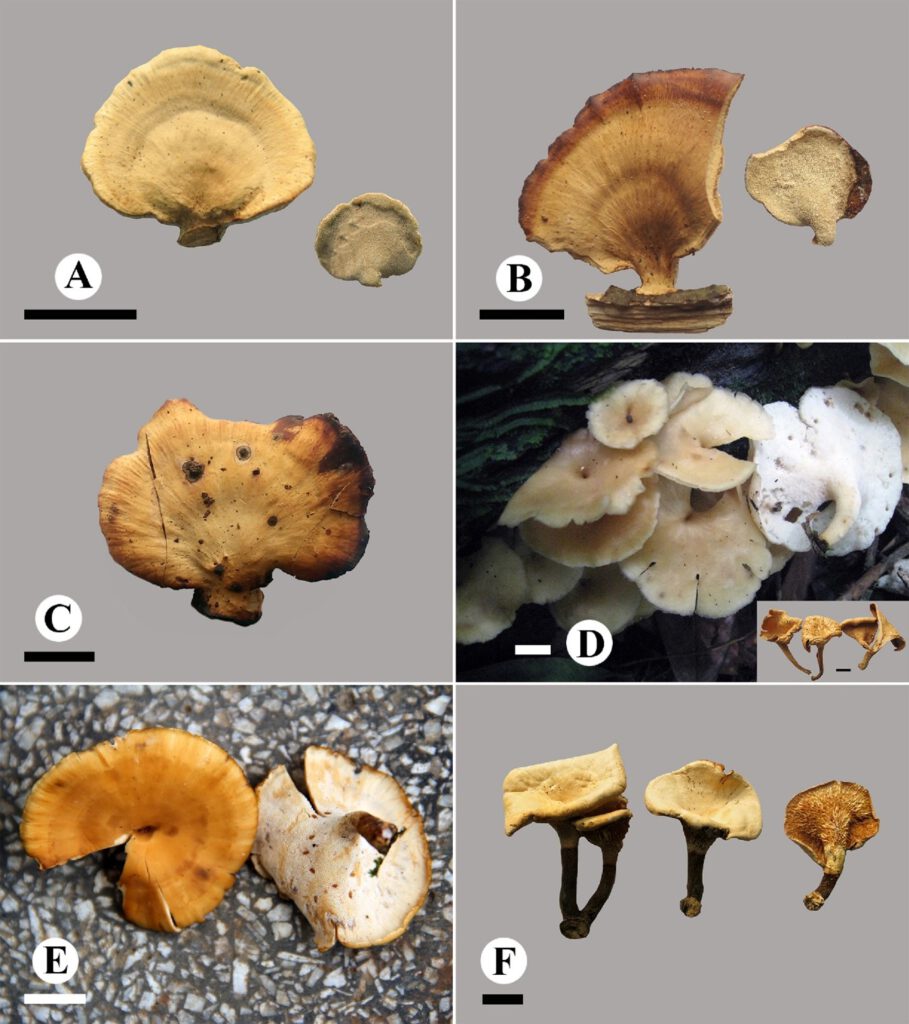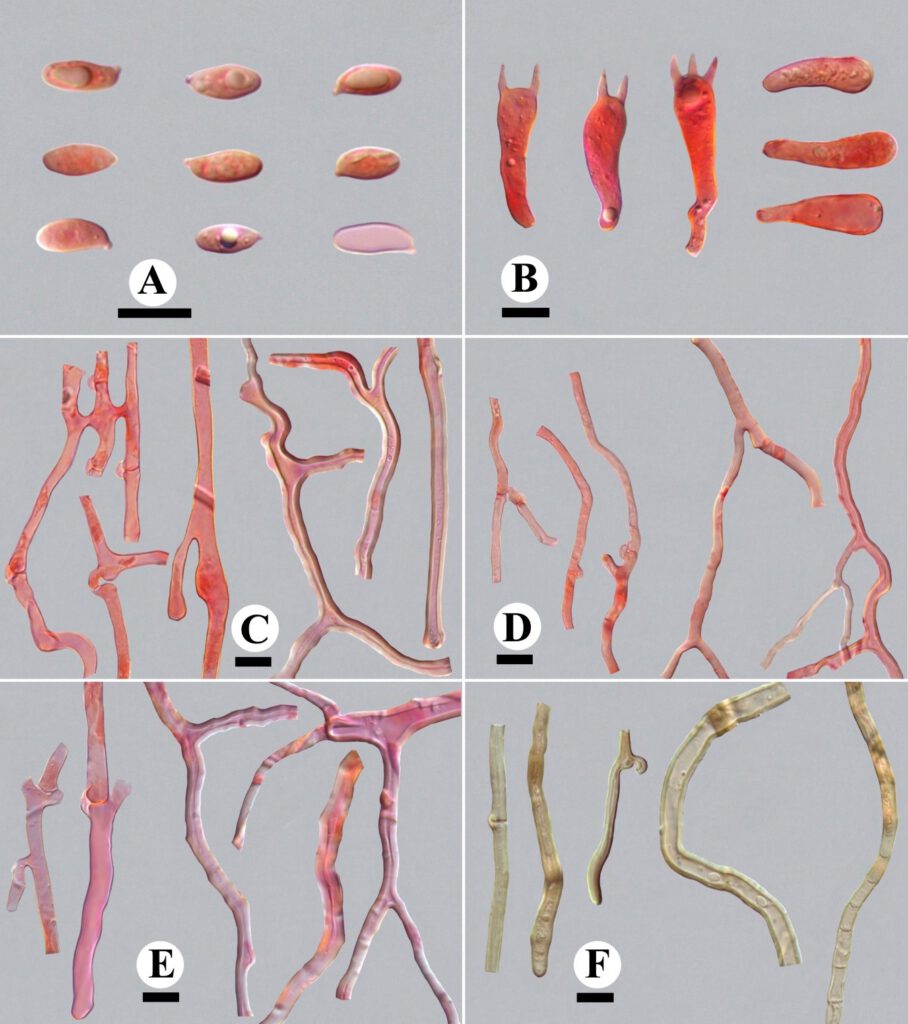Polyporus lamelliporus B.K. Cui, Xing Ji & J.L. Zhou, sp. nov.
MycoBank number: MB 559404; Index Fungorum number: IF 559404; Facesoffungi number: FoF 10652;
Description
Basidiomata – Annual, centrally stipitate, gregarious or clustered, corky to slightly fragile when dry. Pilei flat with a depressed centre or infundibuliform, up to 5.2 cm in diam and 2 mm thick. Pileal surface cream to buff yellow when dry, glabrous and azonate; margin sharp, incurved upon drying. Pore surface buff yellow to light brown when dry; pores angular, usually elongate and lacerate to form lamellae-shaped hymenophores, 0.5–1 per mm, occasionally elongated to 3 mm long and 1.5 mm wide; dissepiments thin, entire to lacerate. Context cream to light ivory when dry, corky upon drying, up to 0.5 mm thick. Tubes lighter than pore surface, fragile when dry, decurrent, up to 1.8 mm thick. Stipe white to cream towards the tubes, brown to black at the lower part, glabrous, 1–3.5 cm long and 2.5–6 mm in diam.
Hyphal structure – Hyphal system dimitic; generative hyphae bearing clamp connections; skeleto-binding hyphae IKI–, slightly CB+; tissues unchanged in KOH.
Context – Generative hyphae frequent, colorless, thin-walled, frequently branched, 2–6 μm in diam, occasionally inflated up to 15.3 μm in diam; skeleto-binding hyphae dominant, colorless, thick-walled with a wide lumen, moderately branched, interwoven, 1.5–8 μm in diam, occasionally inflated up to 19 μm in diam in branching area.
Tubes – Generative hyphae frequent, colorless, thin-walled, frequently branched, 2–5 μm in diam; skeleto-binding hyphae dominant, colorless, thick-walled with a wide to narrow lumen, moderately branched, interwoven, 1.5–5 μm in diam. Cystidia and cystidioles absent. Basidia clavate, with a basal clamp connection and four sterigmata, 27–40 × 8–9.8 μm; basidioles in shape similar to basidia, but slightly smaller.
Stipe – Generative hyphae frequent, colorless, thin-walled, rarely branched, 2–11.5 μm in diam; skeleto-binding hyphae dominant, colorless, thick-walled with a wide to narrow lumen, moderately branched, interwoven, 1.3–8.5 μm in diam, occasionally inflated up to 12 μm in diam in branching area. Hyphae in cuticle with olive yellow to light brown inclusion inside, thick-walled with a wide lumen, bearing both clamp connections and simple-septa, 2.5–8 μm in diam.
Basidiospores – Basidiospores cylindrical, colorless, thin-walled, smooth, frequently bearing one or more guttules, IKI–, CB–, (7.9–)8.4–10.7(–11.5) × (3.3–)3.7–4.7(−4.7) μm, L = 9.42 ± 0.71 μm, W = 4.2 ± 0.25 μm, Q = 2–2.67, Qm = 2.25 ± 0.15 (n=103/3).
Material examined: CHINA, on fallen bamboo, 15 August 2014, Y.C. Dai, Dai 15106 (BJFC, holotype), Dai 15103 (BJFC, paratype); on fallen angiosperm branch, 8 June 2011, Y.C. Dai, Dai 12327 (BJFC, paratype).
Distribution: Tropical and subtropical regions of China.
Sequence data: Dai 15106: ITS: KX851623.1 (ITS4/ITS5); LSU: KX851677.1 (LROR/LR7); nSSU: KX851732.1 (PNS1/NS41); mtSSU: KX851706.1 (MS1/MS2); EF1a: KX851781.1 (983/1567R); RPB1: KX851752.1 (RPB1-Af/RPB1-Cr); RPB2: KX851762.1 (fRPB2-5F/bRPB2-7.1R); TUB: KX851578.1 (Bt-1a/Bt-1b) Dai 12327: ITS: KX851622.1 (ITS4/ITS5); LSU: KX851676.1 (LROR/LR7); nSSU: KX851731.1 (PNS1/NS41); mtSSU: KX851705.1 (MS1/MS2); EF1a: KX851780.1 (983/1567R); TUB: KX851577.1 (Bt-1a/Bt-1b)
Fig. 2–F Basidiomata of Polyporus lamelliporus (Dai 15103). Scale bars: 1 cm. Fig. 12 Microscopic structures of Polyporus lamelliporus. (A): Basidiospores; (B): Basidia and basidioles; (C): Hyphae from context; (D): Hyphae from trama; (E): Hyphae from stipe; (F): Hyphae from cuticle of stipe. Scale bars: A-F = 10 μm.

Fig. 2

Fig. 12
